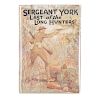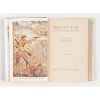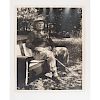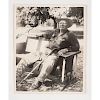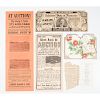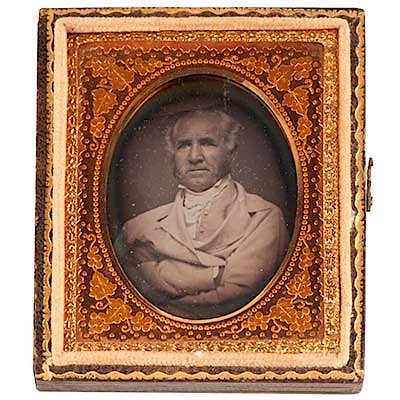Sergeant York Archive, Incl. Photos, Autographs and More
About Seller
6270 Este Ave.
Cincinnati , OH 45232
United States
With offices in Cincinnati, Cleveland and Denver, Cowan’s holds over 40 auctions each year, with annual sales exceeding $16M. We reach buyers around the globe, and take pride in our reputation for integrity, customer service and great results. A full-service house, Cowan’s Auctions specializes in Am...Read more
Two ways to bid:
- Leave a max absentee bid and the platform will bid on your behalf up to your maximum bid during the live auction.
- Bid live during the auction and your bids will be submitted real-time to the auctioneer.
Bid Increments
| Price | Bid Increment |
|---|---|
| $0 | $25 |
| $500 | $50 |
| $1,000 | $100 |
| $2,000 | $250 |
| $5,000 | $500 |
| $10,000 | $1,000 |
| $20,000 | $2,500 |
| $50,000 | $5,000 |
| $100,000 | $10,000 |
About Auction
Nov 16, 2018
Cowan’s Fall American History: Premier Auction features over 200 lots including early photographs, documents, manuscripts, broadsides, flags, and more dating from the Revolutionary War period to the mid-20th Century, many representing important landmark moments in American history. Cowan's Auctions dawnie@cowans.com
- Lot Description
Lot of 10 items, plus, associated with Alvin Cullum York ("Sergeant York") (1887-1964).
Skeyhill, Tom. Sergeant York; Last of the Long Hunters. Philadelphia: John C. Winston Company, 1930. "Long hunters" is how York referred to his ancestors and the people of the Tennessee hills, who hunted, fished and farmed for their living. Signed on ffep "Sgt. Alvin C York." Owner's note on front pastedown "Given to me by Sgt. Alvin C. York June 12, 1957; and autographed on the same day. Harry Holt."
4.5 x 4.75 in. photograph (b-&-w) of an elderly York with a young girl. On verso is "Mary Jane Holt and Sgt. Alvin C York," possibly in Harry Holt's hand (Mary Jane Holt's father).
Another photo shows York on a glider outdoors in the shade, 3.5 x 5 in. With inscription: "To Mary Jane Holt. Sgt Alvin C. York."
An enlargement of same scene, signed "Sgt Alvin C. York," with cover addressed to Harry Holt (mailed in 1955, with return address of Wolf River, TN).
An enlargement of York on the same glider (from opposite side or reversed negative), 8 x 10 in. Signed "Sgt. Alvin C. York." With postal envelope addressed to Harry Holt. Return address is Pall Mall, TN, postal cancel for 1959.
Another group of 14 photographs from the same roll as the previous snapshots (3.5 x 5 in.) includes two more images of York on the same glider, one with a young girl. Both identified as York on verso and dated Sept. 2, 1953. Several photos are identified on verso: "The famous 'York Spring' - Source of water." "House where Mrs. Alvin C. York was born. Small house at side is where Sgt & Mrs. Alvin C. York began 'housekeeping' after their marriage." "Chimney or only remaining portion of the original house where Sgt. Alvin C. York was born." "Pastor Pyles Store." "'Pastor Pyles store' Alvin C. York spent much of his time 'loafing' here." "Front doors of the first church Sgt. Alvin C. York joined." "Methodist Episcopal church that Sgt. Alvin C. York first joined. Cemetery where Sgt York to be buried is on the hill. Joined church after lighting (?) hit him and mule, while coming home drunk." "Present church of Sgt. Alvin C. York. 'First Pilgrim Holiness Church.'" Another group of 13 photographs shows scenes from a military funeral - flower arrangements, lines of cars, soldiers folding the flag, etc. Presume this was York's funeral. Accompanied by a "Jumbo Pak Album" with photos, some possibly from the first group (at least taken in the same house). With 11 photos from York's birthday party in 1958 - various sizes. The birthday cake is decorated with a Medal of Honor design.
Tennessee Cotton Certificate with likeness of a younger Alvin York. Signed by him to the right of his image. 5.5 x 13.5 in. Both upper corners missing, plus a few margin tears.
Christmas card from Sgt. & Mrs. Alvin C. York (presumably sent to the Holts).
Funeral card, 3 x 6.25 in. "In memory of Sgt. Alvin C. York / Born: December 13, 1887 / Pall Mall, Tenn. / Died: / September 2, 1964....." Then lists wife and children. "Saturday, September 5th, 2:00 P.M. / With Full Military Honors. Interment At: Wolf River Cemetery."
Auction flyer, 7 x 14.5 in. Saturday, August 24. (n.y.)
Auction flyer, 7 x 20 in. Thursday, August 30.(n.y., but likely the year after the previous) For "The Alvin C. York 272 Acre Farm and Personal Property."
Plus newspaper pages and clippings. One noting that there were to be some ceremonies to honor York, and included a gift of a vehicle modified to accommodate his wheelchair. Another page shows Harry Holt, with Charles E. "Commando" Kelly and Holt's wife. Baby Mary Jane is in front of the adults wearing a bunch of medals (some purported to be signed by Adolf Hitler), including Kelly's MOH.
Alvin Cullum York (1887-1964) was one of the few heroes to come out of WWI. Born in Fentress County, TN, near the Kentucky state line, York grew up in a hard-drinking, hard-fighting lifestyle. The third of eleven children, Alvin had to help raise his younger siblings when his father died in 1911, his two older brothers having married and moved away from the natal homestead. This was basically only an intensification of the established pattern. The York children had only minimal education, their labor being essential to add to the family income.
In spite of his life of drinking and fighting, Alvin attended church regularly. After a revival meeting at the end of 1914, he had a conversion experience on New Year's Day, 1915. The church he attended formed in part in opposition to the violence of the Civil War, and was generally pacific, although it did not have the overt doctrine of non-violence that others, such as the Friends (Quakers), have. Thus when the US was pulled into WWI, he applied for conscientious objector status but was denied.
COs still had to serve in the WWI draft, but could be assigned non-combat duties. While York appealed his denial, he began military training. He spoke about his psychic discomfort with training for war with a couple of his commanding officers. One, Major G. Edward Buxton, was also a devout Christian, and turned York to Biblical passages that seemed to support war (under some circumstances). York became committed to the fight, being convinced this was what God wanted him to do and would keep him safe.
York was in a unit involved in the Meuse-Argonne Offensive, with a mission to capture Hill 223. When the Germans opened fire on the American troops, Sergeant B. Early, four non-commissioned officers and then-Corporal York and 13 privates were sent to get behind the German lines and take out the machine guns. They infiltrated the line and captured a number of Germans planning an attack on the Americans. But the guns were still active and opened up on the Americans, killing six and wounding three others. York was suddenly the highest ranking officer and so took charge of the operation. While his men guarded the prisoners under cover, York worked his way to the machine guns. He ended up taking them out (along with a number of Germans). York and his seven men returned to camp with 132 prisoners of war.
York was immediately promoted to sergeant. Over the months and years he would be awarded the Distinguished Service Cross, later upgraded to Medal of Honor, plus the equivalent awards by France, Italy and Montenegro. His decorations would eventually add up to nearly 50.
Although recognized by America's European allies, York's heroism went unrecognized in the US. Eventually journalist George Patullo, while touring European battlefields, learned of York's exploits and laid them out for the American audience. York was honored at a number of celebrations, then he returned to the simple life in Tennessee. A week after his return, he and Gracie Williams were married (by the Governor of Tennessee!), followed by more celebrations.
York always refused to profit from his exploits, using his fame instead to better his community in a number of charitable causes. He began by petitioning the state to build a road into the mountains to increase economic development (the road was named for him). He also created a Foundation to increase educational opportunities in the region. The only gift he ended up accepting was the 400-acre farm given him by the Nashville Rotary, but it was not fully stocked or functional and York went in debt trying to make it functional. The Great Depression set in just after the opening of the vocational school, and promised funds disappeared. He mortgaged the farm for bus transportation. Eventually he went to work for the CCC, overseeing the creation of Byrd Lake, then becoming the superintendent of Cumberland Mountain State Park.
During WWI, he tried to enlist again, but age and health were working against him. He was commissioned as a major in the Army Signal Corps. A lot of his role was hosting bond drives in support of the war effort. He also raised funds for charities such as the Red Cross. York was a colonel in the 7th Tennessee State Guard as well as a major in the Signal Corps, but through all he was still referred to as "Sergeant York."
York did tell his story to a couple of journalists in the 1920s. They seemed to foster myths about the "mountain men" of the Appalachian region. Later, at the 1939 World's Fair in New York, he said: "We, the descendants of the pioneer long hunters of the mountains, have been called Scotch-Irish and pure Anglo-Saxon... We in the Tennessee mountains are not transplanted Europeans; every fiber in our body and every emotion in our hearts is American." After a number of refusals, York finally permitted his story to be made into a movie. It became the highest-grossing film of 1941 and received eleven Oscar nominations, two of which won the award. York's earnings were put into his planned Bible school. The Hollywood fame insured that York's name - with "sergeant" in front of it - would endure beyond his earthly existence. After his death, York's farm was purchased by the State of Tennessee, now open as the Sergeant Alvin C. York State Historic Park.
Overall good. Variable as expected.Condition
- Shipping Info
-
Buyers are required to pay for all packing, shipping and insurance charges. Overseas duty charges are the responsibility of the successful Bidder. Be aware that for larger and/or valuable items, shipping charges can be substantial. - If there is no shipping amount on listed your invoice, you will need to make arrangements to pick up or ship your purchase through an alternative shipping company. Our shipping department can be contacted at 513.871.1670 (ext. 219) or email shipping@cowans.com. - Shipping charges include insurance for your order while in transit. If you have private insurance we will adjust your charge to include only packing and shipping. - Please allow 14 – 21 days after payment to package and ship your purchase as carefully as possible.
-
- Buyer's Premium



 EUR
EUR CAD
CAD AUD
AUD GBP
GBP MXN
MXN HKD
HKD CNY
CNY MYR
MYR SEK
SEK SGD
SGD CHF
CHF THB
THB
